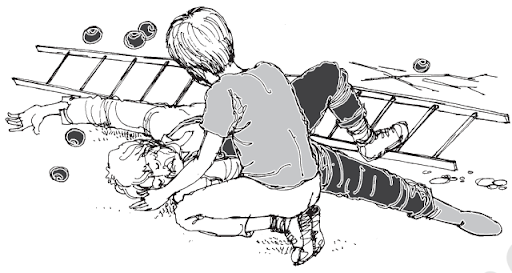On the Face of It Summary – Complete Notes with Q&A for Class 12

Table of Contents
- On the Face of It Summary
- On the Face of It: Questions and Answers Class 12
- About the Author – Susan Hill
- Character Sketches – On the Face of It Class 12
- Themes of On the Face of It – Class 12 Summary
- Symbolism in On the Face of It – Class 12 Summary
- Key Takeaways from On the Face of It
- Readers Also Read
- Learn and Explore Literature with PlanetSpark
- Conclusion – On the Face of It Summary
- FAQs – On the Face of It Class 12
On the Face of It is a thought-provoking play by Susan Hill included in the Class 12 English syllabus. It explores the meeting between Mr. Lamb, an elderly man with a tin leg, and Derry, a withdrawn boy scarred by an acid accident. Through their conversation, the play highlights themes of acceptance, loneliness, inner strength, and the human need for connection. This blog provides a complete On the Face of It summary, theme, analysis, and FAQs to help students understand the play easily for exams.
On the Face of It Summary
On the Face of It Summary Scene 1– Derry Meets Mr. Lamb in the Garden
The play opens in Mr. Lamb’s garden, with the gentle sounds of birds and rustling leaves. Derry, a 14-year-old boy with a scarred face caused by an acid accident, wanders in, thinking the place is empty. Startled by Mr. Lamb’s sudden greeting, Derry initially reacts defensively.
Mr. Lamb introduces himself and warmly welcomes Derry, encouraging him not to fear the garden. Through their conversation, Derry reveals his insecurities, explaining that people are afraid of him because of his appearance. Mr. Lamb responds with empathy and calmness, showing that external appearances do not define a person’s worth. He speaks about life, nature, and human connections in ways that intrigue Derry.
This scene establishes the central theme of the play: acceptance and seeing beyond physical appearance. The garden represents a safe, open space where Derry feels free to express his fears and thoughts without judgment.
Book Your Free Demo Today!
Explore Class 12 literature with expert guidance.
On the Face of It Summary Scene 2 – Building a Bond and Discussing Differences
In Scene 2, Derry and Mr. Lamb’s relationship deepens as they discuss their respective disabilities. Derry expresses his frustration about being judged for his scarred face, while Mr. Lamb reveals that he lost his leg in a war. Despite their physical limitations, Mr. Lamb shows resilience, positivity, and a love for life.
Through this dialogue, Mr. Lamb challenges Derry’s perception of the world. He explains that people who focus only on appearances miss the richness of life. Derry, who has been withdrawn and defiant, slowly begins to open up, realizing that inner strength, courage, and human connection matter more than outward beauty.
The scene also highlights Mr. Lamb’s philosophical outlook on life, he views nature, weeds, bees, and apples as metaphors for life’s diversity and value. By the end of the scene, Derry feels a sense of hope and curiosity, considering the possibility of trust and friendship.
On the Face of It Summary Scene 3 – Courage, Friendship, and Loss
In the final scene, Derry decides to return to Mr. Lamb’s garden to help him pick crab apples. The act demonstrates Derry’s growing courage and willingness to connect with others. However, tragedy strikes when Mr. Lamb falls from the ladder while picking apples and dies.
Despite the loss, Derry has undergone a significant emotional transformation. The play concludes with a message that life is unpredictable, but meaningful interactions and acts of courage leave a lasting impact. Derry learns the importance of self-acceptance, empathy, and seizing opportunities for personal growth, even if circumstances do not go as planned.
This scene reinforces the play’s key lessons: true beauty lies within, friendships and connections are transformative, and life’s value is measured by one’s attitude, not appearance.

On the Face of It: Questions and Answers Class 12
1. What draws Derry towards Mr. Lamb despite himself?
Derry is initially withdrawn, defiant, and wary of people because of the reactions his scarred face provokes. However, he is drawn to Mr. Lamb because of the old man’s warmth, non-judgmental attitude, and genuine curiosity about the world. Mr. Lamb treats Derry as a person rather than focusing on his appearance, showing empathy and patience. The openness of the garden, Mr. Lamb’s stories, and his calm, accepting nature make Derry feel safe and understood. Despite himself, Derry is attracted to this sense of freedom and companionship that he has rarely experienced.
2. In which section of the play does Mr. Lamb display signs of loneliness and disappointment? What are the ways in which Mr. Lamb tries to overcome these feelings?
Mr. Lamb’s loneliness and disappointment emerge subtly in his conversations about life and people. He shares how neighbors and children call him “Lamey-Lamb” and how society often judges him for his tin leg. Despite this, he has cultivated resilience and optimism. Mr. Lamb overcomes loneliness by:
Connecting with nature: He finds joy in gardening, bees, apples, and weeds.
Welcoming people into his garden: He opens his home and garden to anyone who visits.
Maintaining curiosity: By asking questions and observing the world, he keeps his mind active and engaged.
These actions show that Mr. Lamb’s positive outlook and self-acceptance help him transcend feelings of isolation.
3. The actual pain or inconvenience caused by a physical impairment is often much less than the sense of alienation felt by the person with disabilities. What is the kind of behaviour that the person expects from others?
The play highlights that the emotional impact of social alienation often outweighs the actual physical inconvenience. Derry’s burned face does not physically prevent him from living, but the constant fear of judgment isolates him. Individuals with disabilities expect:
Empathy and understanding: To be treated as a person, not defined by their impairment.
Respect for individuality: To have their abilities and thoughts recognized rather than focusing on their differences.
Non-judgmental behavior: Acceptance from society without pity or fear.
Mr. Lamb models this behavior, showing that support and openness can significantly reduce the alienation felt by those with disabilities.
4. Will Derry get back to his old seclusion or will Mr. Lamb’s brief association effect a change in the kind of life he will lead in the future?
Mr. Lamb’s brief but meaningful interaction has a profound effect on Derry. The garden experience and Mr. Lamb’s acceptance:
Give Derry confidence in himself.
Show him that friendship and human connection are possible despite physical differences.
Encourage him to explore the world and step outside his self-imposed isolation.
While Derry may still face societal prejudice, the encounter with Mr. Lamb suggests that he is unlikely to revert entirely to seclusion. The play ends on a hopeful note, implying that Derry’s future will involve greater openness, courage, and self-acceptance.
Experience Interactive Literature Classes
Schedule your PlanetSpark demo now.
About the Author – Susan Hill

Susan Hill is a celebrated British author and playwright, born in 1942. She is known for her simple yet powerful writing that explores human emotions, loneliness, and social challenges. In On the Face of It, she addresses physical disability, prejudice, and personal growth through Derry and Mr. Lamb.
Her works, including The Woman in Black, are widely studied in the Class 12 curriculum for their moral and psychological insights, making complex themes accessible to students.
Character Sketches – On the Face of It Class 12
1. Derry – The Withdrawn and Scarred Boy
Derry is a 14-year-old boy with an acid-scarred face, which makes him self-conscious and withdrawn. His appearance has led to social isolation and a deep fear of judgment. Initially defiant and mistrustful, Derry believes that people will always reject or pity him because of how he looks.
Key Traits:
Insecure and defensive: Derry avoids people to protect himself from hurtful reactions.
Observant: He notices details about people’s reactions and behavior.
Curious and reflective: Despite his fears, he is drawn to Mr. Lamb’s kindness and wisdom.
Potential for growth: By the end of the play, Derry begins to experience hope, trust, and courage.
Role in the Play:
Derry represents the emotional and psychological struggles faced by those who are judged for their appearance. His interaction with Mr. Lamb highlights the transformative power of empathy and human connection.
2. Mr. Lamb – The Wise and Compassionate Old Man
Mr. Lamb is an elderly man with a tin leg, which he lost during the war. Despite his physical limitation, he exudes confidence, optimism, and a love for life. He lives alone but remains open to people, nature, and experiences.
Key Traits:
Compassionate and non-judgmental: Treats Derry as a person, not defined by his scarred face.
Wise and philosophical: Uses stories, nature, and experiences to impart life lessons.
Optimistic and resilient: Lives life fully despite personal hardships.
Encouraging mentor: Helps Derry gain confidence, self-acceptance, and a positive outlook.
Role in the Play:
Mr. Lamb is the catalyst for Derry’s transformation. Through his empathy, wisdom, and encouragement, he teaches Derry the importance of inner strength, resilience, and acceptance.
3. Derry’s Mother – Protective and Concerned
Although she appears briefly, Derry’s mother is a significant influence. She worries about her son’s safety and the social judgment he faces. She is cautious about Derry interacting with others, even someone as kind as Mr. Lamb.
Key Traits:
Protective: Seeks to shield Derry from harm and judgment.
Practical: Emphasizes safety and caution over exploration.
Limited understanding: Her concern sometimes clashes with Derry’s desire for independence and personal growth.
Role in the Play:
She represents societal concerns and the instinct to protect a child from external judgment. Her presence contrasts with Mr. Lamb’s open, accepting approach, highlighting the tension between sheltering and empowering Derry.
Join a Trial Class for Free!
Understand themes, symbolism, and character sketches effortlessly.
Themes of On the Face of It – Class 12 Summary
1. Appearance vs. Reality
A central theme of the play is the contrast between outward appearance and inner reality. Derry is judged and feared because of his acid-scarred face, while Mr. Lamb is initially seen as an old man with a tin leg. Both characters demonstrate that true worth lies in one’s character, actions, and attitude, not physical appearance. The play encourages readers to look beyond the surface and value inner qualities.
2. Alienation and Loneliness
Derry experiences emotional isolation due to societal reactions to his appearance. Mr. Lamb, despite his optimism, also knows loneliness because of his physical disability and living alone. The play explores how alienation affects emotional well-being and how human connection and understanding can help overcome loneliness.
3. Empathy and Human Connection
The bond that develops between Derry and Mr. Lamb illustrates the importance of empathy, compassion, and acceptance. Mr. Lamb treats Derry without judgment, listens to him patiently, and helps him see beyond his fears. This theme emphasizes that genuine relationships can empower individuals and help them overcome personal insecurities.
4. Courage and Self-Acceptance
The play highlights the courage needed to face a world that judges based on appearances. Through Mr. Lamb’s guidance, Derry begins to accept himself and confront societal prejudice. The theme stresses that inner strength and self-belief are essential for personal growth.
5. Freedom and Nature as a Metaphor
The garden is not just a setting but a symbol of freedom, learning, and growth. In the garden, Derry experiences safety, curiosity, and connection. The theme shows how open spaces and nature can foster understanding, reflection, and liberation from societal constraints.
6. Prejudice and Social Judgment
The play deals with society’s tendency to judge individuals by their physical appearance, highlighting the emotional pain caused by prejudice. Derry’s fear of people’s reactions shows how social judgment can limit personal growth and reinforce isolation.

Symbolism in On the Face of It – Class 12 Summary
1. The Garden
The garden represents freedom, safety, and personal growth. It is a place where Derry feels comfortable to express himself without fear of judgment. The garden also symbolizes a world beyond societal prejudices, where human connection and empathy can flourish.
2. Crab Apples
The crab apples symbolize the sweetness and effort of life’s rewards. Mr. Lamb invites Derry to help him pick them, which represents cooperation, trust, and shared experiences. It also reflects the idea that beauty and satisfaction in life often require patience and care.
3. Mr. Lamb’s Tin Leg
The tin leg symbolizes physical impairment but not limitation. It represents resilience, optimism, and the idea that one’s disability does not define one’s worth. Mr. Lamb’s leg contrasts with Derry’s face, showing how people respond differently to social prejudice versus self-acceptance.
4. Derry’s Scarred Face
Derry’s face symbolizes societal judgment, fear, and emotional isolation. It is the source of his insecurity and mistrust of others. However, it also becomes a catalyst for growth as he learns from Mr. Lamb that his inner qualities define him more than his appearance.
5. Bees and Nature
Bees and other elements of nature symbolize life, observation, and learning. Mr. Lamb uses them to teach Derry about patience, beauty, and finding meaning beyond appearances. They highlight the importance of awareness, curiosity, and mindfulness in personal growth.
Key Takeaways from On the Face of It
Don’t judge people by appearance: The play emphasizes that physical looks are not indicative of a person’s worth.
Empathy and compassion matter: Human connection can overcome fear and isolation.
Inner strength fosters resilience: Both Derry and Mr. Lamb show that courage comes from self-acceptance.
Loneliness can be mitigated through openness: Engaging with others and nature reduces feelings of alienation.
Personal growth requires risk-taking: Derry learns to step out of his seclusion and explore the world despite societal prejudices.
Mentorship and guidance can be transformative: Mr. Lamb’s support illustrates how wisdom and understanding can inspire change.
Hope and courage are timeless: The play ends on a hopeful note, showing that a brief, meaningful interaction can spark lifelong change.
Readers Also Read
The Tiger King – A satirical tale about pride, fate, and human folly as a king hunts 100 tigers, ignoring a prophecy.
Keeping Quiet – Pablo Neruda’s poem urging silence and introspection to understand oneself and the world.
Poets and Pancakes – A humorous look at life in Gemini Studios, exploring creativity, identity, and work.
My Mother at Sixty-Six – Kamala Das reflects on her mother’s aging, highlighting love, loss, and the passage of time.
Lost Spring – Stories of underprivileged children deprived of childhood, exploring poverty and social injustice.

Learn and Explore Literature with PlanetSpark
At PlanetSpark, we help students build a deep understanding of literature, including plays like On the Face of It. Our interactive programs make learning engaging, easy to understand, and exam-ready.
Why Choose PlanetSpark for Literature Learning?
Concept Clarity: Understand themes, symbolism, and character insights in depth.
Interactive Classes: Participate in discussions, role-plays, and scene analysis for better retention.
Expert Guidance: Learn from experienced teachers who simplify complex ideas for Class 12 students.
Exam Preparation: Focused lessons that prepare students for board exams and assessments.
PlanetSpark empowers students to analyze texts critically, appreciate literary nuances, and express their ideas confidently, skills that go beyond the classroom and help in overall academic growth.
Conclusion – On the Face of It Summary
On the Face of It by Susan Hill is a powerful play that explores appearance versus reality, empathy, and personal growth. Through the friendship between Derry and Mr. Lamb, students learn the importance of looking beyond physical differences, overcoming fear, and valuing inner qualities. The play emphasizes that human connection, courage, and self-acceptance can transform lives, making it a relevant and inspiring read for Class 12 students.
By studying this play, students gain insights into social prejudice, loneliness, and resilience, while also enhancing critical thinking and analytical skills.
FAQs – On the Face of It Class 12
Q1. Who are the main characters in On the Face of It?
A: The main characters are Derry, a boy with an acid-scarred face, and Mr. Lamb, an old man with a tin leg. Their interaction forms the heart of the play.
Q2. What is the central theme of the play?
A: The play focuses on appearance versus reality, human empathy, personal growth, and the courage to face societal prejudice.
Q3. Why does Derry feel isolated and withdrawn?
A: Derry experiences emotional alienation due to society’s fear and judgment of his scarred face, making him wary of human connection.
Q4. How does Mr. Lamb influence Derry?
A: Mr. Lamb shows Derry that inner strength, courage, and self-acceptance matter more than physical appearance, inspiring him to overcome fear and isolation.
Q5. What does the garden symbolize in the play?
A: The garden represents freedom, safety, growth, and a world beyond social prejudice, where Derry can express himself without fear.
Download Free Worksheets
Personalized Communication Report
Record a video to get a AI generated personalized communication report for your child

Hi There, want to try these
tips for your child with
LIVE with our expert coach?
Let's check your child's
English fluency

